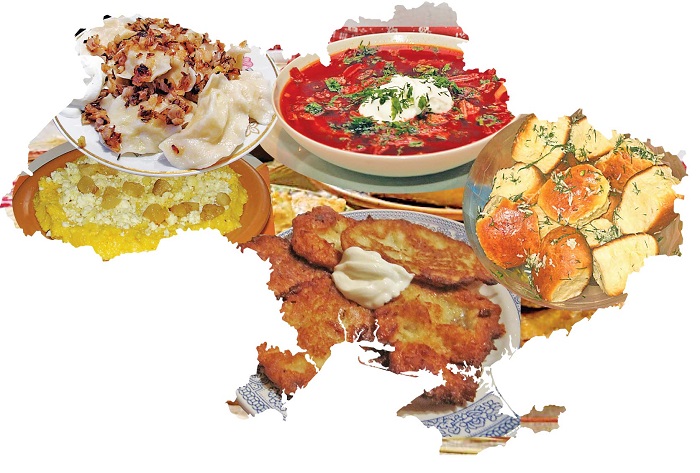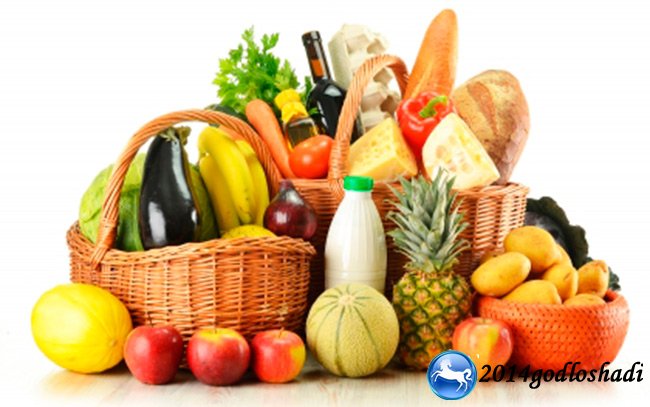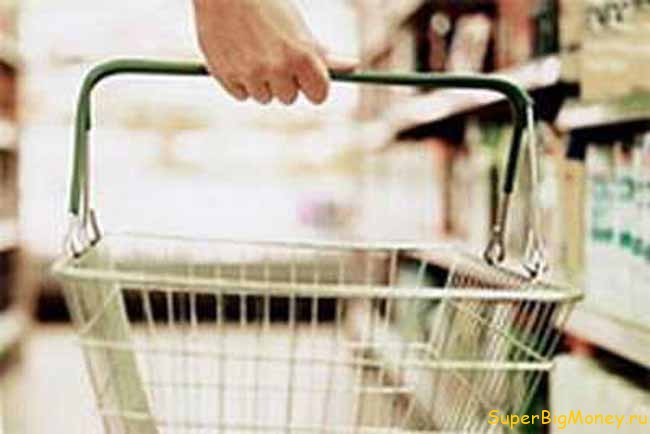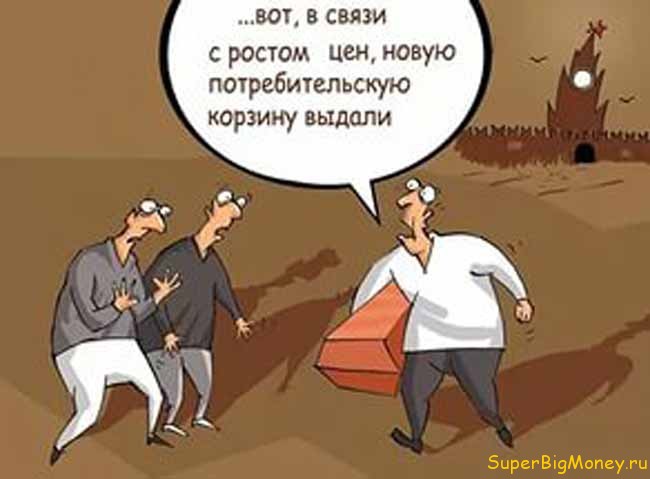The Russian Federation is a state for which its citizens are of paramount importance. Government actions and social programs are designed in such a way that Russians can live with dignity. This was the position held by the federal authorities until 2017.
To control the security of citizens, the installation of certain standards is required. Their main purpose is to guide. In 2017, one of these standards is the consumer basket, which includes products and services that should be available to any resident of Russia, regardless of their income level.
Speaking about such a concept as a consumer basket, it should be noted that this is a combination of a number of goods and services that are of paramount importance for Russians. This standard is directly related to such definitions as the minimum wage, as well as the cost of living.
Naturally, when forming the consumer's basket, the government took into account the lowest prices and quantity of products. The main task was to preserve the viability, ability to work and relative health of citizens. Unfortunately, the introduction and calculation of this standard was carried out a considerable time ago, and today, the consumer basket is not distinguished by a particular variety.
Speaking about the theoretical side of this issue, the income of Russians should allow them to buy all goods and services included in the consumer's basket. This includes not only able-bodied residents, but also socially unprotected categories of citizens, such as pensioners and the disabled.
With a shortage of funds, the task of the state is to financially support a citizen with the help of targeted additional payments and benefits. Alas, the reality is quite different. The concerns and problems of ordinary residents practically do not bother anyone, and the Russians are forced to solve them on their own. First of all, this is due to the fact that the subsistence minimum is more than 30% higher than the minimum wage in 2017.
A similar situation is observed not only on the territory of the Russian Federation. For example, if you pay attention to the consumer basket of Ukraine, then it has not been updated since its initial formation until October 2016. In Russia, the consumer basket was updated in 2013, but, in reality, the situation does not differ much from the Ukrainian one.
Standards adopted to improve the lives of citizens must be updated regularly. The revision of such an indicator as the cost of living is carried out quarterly. This is not surprising, since the prices of goods and services are constantly increasing.
Concerning consumer basket, then it is scheduled to be updated every 5 years. This approach surprises almost all Russians, because every year their standard of living does not improve, but, on the contrary, gets worse.

In past years, the Russian authorities wanted to correct the mistake they had made and direct all their efforts to balancing such indicators as the subsistence minimum and the minimum income level. Alas, the aspirations were not destined to come true. When relations with friendly Ukraine deteriorated significantly, leading to the emergence of any problems with other states, plans for a radical revision of income levels were postponed until better times.
When conducting a detailed analysis of the consumer's basket, it can be found that the price of all items listed in the list is significantly higher than the minimum income of Russians. Of course, able-bodied residents of Russia quite successfully deal with a similar problem, but what about pensioners, the disabled and other socially vulnerable segments of the population.

The formation of a consumer basket is a complex process that requires careful study and analysis of all components. In order to solve the task as effectively as possible, the Russian authorities apply an individual approach, conducting an appropriate assessment of each subject separately. First of all, the government needs to determine the primary needs of the inhabitants in the region, taking into account climatic conditions and other factors. The study and subsequent decision-making is carried out by a tripartite commission created specifically for this purpose.
Many Russians confuse the consumer basket and the level of the minimum income. In fact, these 2 terms serve different purposes. Speaking about the subsistence minimum, it should be noted that its approval is carried out both throughout Russia as a whole and at the regional level.
Speaking about the minimum income, which is calculated at the federal level, there are no special questions, since the government approves the budget, which means that it is necessary to find out the average level of well-being of residents. The appointment of a regional subsistence minimum is aimed at similar goals, but it is in the region that payments should be taken into account to support socially vulnerable categories of citizens, such as minor children, the poor, large families, pensioners and many others.

Analyzing the situation that developed in 2016 on the territory of Ukraine, it becomes clear that it is no better than the Russian one. Before recent changes The Ukrainian consumer basket included about 300 items, including not only essential goods, but also leisure. At first glance, everything is calculated to the smallest detail. In reality, the situation is shocking.
The subsistence minimum in Ukraine, as of 2017, is 1,544 hryvnias. Along with this, the value of the minimum pension is 1247 hryvnia. If we calculate the goods and services included in the consumer basket, we get an amount that is several times higher than the established standards.
It was already mentioned above that the consumer's basket was not subject to changes until October 2016. It is noteworthy that the changes that have taken place over the past years do not excite the government at all.
If you pay attention to the daily diet, which Ukrainians must comply with in accordance with the accepted standards that have been observed for the past 16 years, there can be no question of working capacity, comfortable life, and even more so health:
- 7 gr. rice
- 100 gr. meat products;
- 2 small potatoes;
- 1/2 egg;
- 170 gr. bakery products;
- 200 gr. milk.
It is surprising that such goods as tea or coffee were not included in the list at all. Most likely, according to the Ukrainian government, such products are a luxury. It should also be noted that even if a resident of Ukraine decides to limit his diet and eat exclusively according to the menu proposed by the government, the subsistence level will not be enough even to purchase such a meager ration.
According to calculations, until 2016, Ukrainians had to spend no more than 20 hryvnias on food every day. If we take into account 300 items of goods and services included in the previous consumer basket, then a completely understandable question arises regarding the financial component.
In order to find out the fact that the calculation of the consumer basket in Russia and Ukraine is incorrect, you do not need to have a diploma in economics. The real situation is such that residents are forced to solve their problems on their own and look for opportunities to survive. As for the differences between the consumer basket and the subsistence minimum, they, apparently, have long since become the norm.
Despite the changes in the consumer basket in 2016, the question still arises: how can the average Ukrainian live on this meager set of products?
Consumer basket. The truth of life.
Everyone, of course, prefers to calculate their expenses based on their own earnings. Although, of course, the state sets the living wage, based on the state budget and the basic needs of the population, without which it is impossible to survive. That is, the cost of living and, as a result, consumer basket in 2017 is compiled only on the basis of what a person needs to live, not to live a full life.
So what will be the consumer basket of 2017 in Russia, what will be included in it, and also how will the consumer basket differ for certain regions?
The cost of the consumer basket in 2017
There are three types of consumer baskets (PC): for able-bodied citizens (persons over 16 years old), for minor children and for non-working citizens who have reached retirement age. The fact is that for each resident of the Russian Federation, depending on the group, the content of the PC is made up of various necessary products.
The consumer basket has survived the latest news and changes in Russia quite steadily, and even more: the cost of the consumer basket for an adult has increased by about 200 rubles (in percentage terms, this number is about 3.2%), for a child - by 250 rubles (3.9%, respectively). ), and for pensioners - by 411 rubles (10% approximately).
The cost of the required minimum for adults is 6,300 rubles a month, for minor children - 6,400 rubles, and for elderly pensioners, oddly enough, only 5,400 rubles.
The cost of the consumer basket plays an important role in calculating the minimum wage, social benefits, and determining the ability of the masses as buyers.
The consumer basket exists not only in the CIS countries, but throughout the world. Unfortunately, for the EU and America, the minimum consists of a much larger list of products: in England, the number of goods and services is 350, in Germany - as much as 475. Even in America, the list includes almost twice as many as in Russia - 300 goods and services . In Russia, there are 156 items on the list.
Once every three or four years, depending on changes in prices and wages, the cost of the basket is recalculated, and even more rarely its composition is changed, depending on changes in the needs of the masses.

In different regions, the composition of the PC is different. And if in the largest regions - Moscow and Leningrad - it practically does not differ. Most a large number of products in the PC - in the Murmansk region, for example, bread products for residents of Murmansk are required by 26 kg more than for residents of Moscow, and fruits - by 5 kg more.
According to preliminary information, the minimum cost of the New Year's table in 2017 will be 5800 rubles. In addition to commonly consumed products, the basket for the New Year holidays will include smoked meats, both fish and meat, sausage, red caviar, cheese, fruit, something sweet - for example, sweets or cake, and, of course, champagne.
The composition of the consumer basket for 2017
The consumer basket includes a small amount of clothing, footwear, household appliances and medicines. Based on the calculation, an adult will receive two jackets, with and without a fur lining, and a coat or raincoat for 7.6 years. For old people, the same set of outerwear is calculated for 8.7 years. For children, due to the active stage of growth, such a set of clothes will last only 2.6 years.
From the minimum set of outerwear, adults for 4 years will get a suit, three shirts, trousers and jeans for men and two dresses for women, two sweaters and a suit for sports. This set will last for the elderly for a year more, and for children - for 2 years less.
Five pairs of shorts, three T-shirts for men and a slightly larger list for women, namely two nightgowns, two bras and two combinations - this, according to the state, is necessary for the Russian population for 2.4 years.
It is planned that 7 pairs of socks will be enough for a man for 1.5 years, and 5 pairs of tights for a woman.
Shoes for all age groups are purchased with the expectation of "two pairs - for a year."
The list also includes hats, a scarf, gloves, notebooks and pens.
The consumer basket includes housing and public utilities: so, for one person, the state expects 18 square meters of living space, 285 liters of water, 10 m3 of gas and 50 kW of energy. Also enough for 618 trips by public transport per year.
A person should have enough money for 5 cultural events per year.
![]()
The main part of the PC, of course, is food.
The Government of the Russian Federation calculates that each person needs approximately 1 ton of potatoes, 115 kg of vegetables, 60 kg of fruit, 130 kg of bread and flour products, 60 kg of meat and 20 kg of fish, 20 kg of sugar, 180 eggs, 13 kg of butter and 220 kg of milk. Thus, a person will have to consume only 300 g of bread, 280 g of potatoes, 80 g of milk, 50 g of fish and 180 g of meat per day. As you can see, the number of products is scanty and absolutely does not correspond to modern realities.
Unfortunately, looking at the figures, it is easy to see that the true figures are much higher than those compiled by the state, and are absolutely not comparable with modern real spending. That is why ordinary people are very concerned about the question of how much the composition of the consumer basket will change for 2017, and whether it will become easier for people to live.
In many states there is such a thing as a consumer basket. It is defined by law, and is a minimum detailed set of products and services necessary for a comfortable life. It is different in different countries. So, in Germany this set consists of 475 items, in England - from 350. We will also consider what will be the consumer basket in 2017in our country.
Russia has adopted a new composition of the consumer basket, valid until 2018. It consists of three categories: food, non-food products and services. A total of 156 items worth about 9.8 thousand rubles. Of course, in different regions of the country, the cost of the components of the basket is different, the indicated amount is the average Russian one. For example, for the northern regions, a multiplying factor is relevant. Higher prices in the capital and major cities.
The full line-up andconsumer basket value in 2017in the region of interest, you can look at the relevant Internet resources. Let's take a look at the categories in general.
Food.
This category has a share of approximately 50% of the total composition of all baskets. The products included in the list comply with officially accepted standards for healthy eating and even take into account the nutritional value required for different ages. Yes, for able-bodied population the established number of calories is 2.5 thousand kcal, for pensioners - 2.2 thousand kcal, for children - 2 thousand. List of products that has consumer basket 2017 in Russia,per person per day is as follows:

- Various types of bakery products - 0.3 kg;
- Vegetables - 0.58 kg;
- Fruit - 0.16 kg;
- Sweet (including sugar) - 0.06 kg;
- Vegetable oils - 0.04 kg;
- Eggs - 0.5 pcs;
- Various meat and products from it - 0.16 kg;
- Fish, seafood - 0.05 kg.
In general, the list of products for the day is quite acceptable.. And from the point of view of filling the basket, everything is fine. However, the population and specialists have some doubts, and they are connected with the cost of these products. Repeatedly, media representatives made attempts to buy these products for the required amount of money, and each time they were not entirely successful. The conclusion is like this: the cost of the consumer basket and, as a result, the size of the subsistence minimum with an adequate set of products is artificially low by at least 1.5, or even 2 times.
Non-grocery goods
In addition, in order to eat, a person also needs to get dressed, buy household goods and medicines. These needs are half the cost of food. This value in the current consumer basket was determined on the basis of average statistical data on actual expenditures. That is, 2.45 thousand rubles should, on average, be enough for a person per month for clothes, medicines, household goods, household chemicals and other things.
In the relevant documents that determine the procedure for the formation of this category, it is noted that all the needs of the population are taken into account. At the same time, it is taken into account that there are no costs for medical care - it is free in our country.

Services
The same amount is provided for payment of the required services. This includes utilities, transportation costs, cultural events, and so on. Although it is unlikely that there will be enough funds for “further”.
With this money you can pay utility bills for a one-room apartment in St. Petersburg. Or one ticket to the theater for an opera or ballet. Or a ticket for all types of transport. It remains only to choose what is more important. In fairness, it should be noted that in fact 2.45 thousand rubles is not enough for this, since the travel ticket costs 2690 rubles, the theater costs 2800, and utility bills in the winter can be higher than 3000 rubles.

Conclusion
The consumer basket shows not only the standard of living of the country's population. It is used to calculate the living wage, minimum wage, benefits. With a similar set of products, the cost of the consumer basket, or its monetary equivalent, differs by region.
Based on the available information about the consumer basket, including the one presented in the article, each reader can form their own opinion about this concept, its relevance and expediency. And just for the sake of curiosity, try to live on the indicated amounts, or buy the listed set of products. Of course, taking into account inflation will change andconsumer basket 2017 in Russia. Latest newsconfirm this fact and refer to the estimated figures of 4-5% as a forecast. However, it is unlikely that such values will make a significant change in the quality of life of the population. I am glad that this issue is regularly raised by the country's leadership, and the need for a radical solution to the issue is recognized. Let's hope that together with the expected stabilization of the economy, the issue of filling and cost of the basket will be raised and resolved, since it is extremely important for the majority of the population receiving social benefits.
The consumer basket is a set of goods and services that provide a comfortable and full-fledged stay of a person throughout the year and satisfy his minimum needs. The composition of the consumer basket directly affects the subsistence minimum, which is reviewed every year depending on the price level.
What is included in the consumer basket in 2017?
On January 1, 2013, a new consumer basket came into force, which will be valid until 2018.
The consumer basket primarily includes food products, which make up about 50% of its value (for comparison, in Western Europe, this figure does not exceed 20%). It is worth mentioning that most Russian families also spend more than half of their family income on food.
The second group includes non-food products - clothes, shoes, hats, underwear, medicines.
Well, the third group of the consumer basket consists of services: utilities, transport costs, cultural events, and so on.
So, if you look at the table below, which shows the products and services included in the consumer basket for 2017, you will see that, according to government calculations, an able-bodied citizen consumes 100.4 kg per year. potatoes, 114.6 kg. vegetables, 60 kg. fresh fruit, 126.5 kg. bread and bakery products, 58.6 kg. meat and 18.5 kg of fish products, respectively. Cultural services account for 5% of the total monthly expenses.
What does this mean per person per day? And this means that for a normal existence, an ordinary average citizen of the Russian Federation should consume 300 g of bread per day, 280 g of potatoes, 300 g of vegetables, 160 g of fresh fruits, 60 g of sweets, milk and dairy products. products - 800 g, vegetable oils and fats - 40 g. And also eat one egg once every 2 days, be content with 160 g of meat per day, and eat 350 g of fish per week. As for cultural development, here an able-bodied Russian citizen has a chance to go to the cinema or theater once a month, there is no money provided for more for these purposes.
1. Food
| Name | unit of measurement | Consumption volume (average per person per year) | ||
| Working-age population | pensioners | children | ||
| Bread products (bread and pasta in terms of flour, flour, cereals, legumes) | kg | 126,5 | 98,2 | 76,6 |
| Potato | kg | 100,4 | 80,0 | 88,1 |
| Vegetables and gourds | kg | 114,6 | 98,0 | 112,5 |
| Fresh fruits | kg | 60,0 | 45,0 | 118,1 |
| Sugar and confectionery in terms of sugar | kg | 23,8 | 21,2 | 21,8 |
| meat products | kg | 58,6 | 54,0 | 44,0 |
| fish products | kg | 18,5 | 16,0 | 18,6 |
| Milk and dairy products in terms of milk | kg | 290,0 | 257,8 | 360,7 |
| Eggs | thing | 210,0 | 200,0 | 201,0 |
| Vegetable oil, margarine and other fats | kg | 11,0 | 10,0 | 5,0 |
| Other products (salt, tea, spices) | kg | 4,9 | 4,2 | 3,6 |
2. Non-food items
| Name | Unit of measurement / wear period | |||
| able-bodied population | pensioners | children | ||
| Upper coat group | pieces/years | 3/7,6 | 3/8,7 | 3/2,6 |
| Upper costume and dress group | pieces/years | 8/4,2 | 8/5,0 | 11/2,0 |
| linen | pieces/years | 9/2,4 | 10/2,9 | 11/1,8 |
| Hosiery | couples/years | 7/1,4 | 4/1,9 | 6/1,3 |
| Headwear and haberdashery | pieces/years | 5/5,0 | 4/5,6 | 4/2,8 |
| Shoes | couples/years | 6/3,2 | 6/3,5 | 7/1,8 |
| School-written goods | pieces/years | 3/1,0 | 3/1,0 | 27/1,0 |
| Bed sheets | pieces/years | 14/7,0 | 14/7,0 | 14/7,0 |
| Goods for cultural and household purposes | pieces/years | 19/10,5 | 19/10,5 | 19/10,5 |
| Daily necessities, sanitation and medicines | percent of total spending on non-food items per month | 10 | 15 | 12 |
3. Services
| Name | unit of measurement | Volume of consumption (average per person) | ||
| able-bodied population | pensioners | children | ||
| Housing | sq. m of total area | 18 | 18 | 18 |
| Central heating | Gcal per year | 6,7 | 6,7 | 6,7 |
| Cold and hot water supply and sanitation | l per day | 285 | 285 | 285 |
| Gas supply | cube m per month | 10 | 10 | 10 |
| Electricity | kWh per month | 50 | 50 | 50 |
| services | trips per year | 619 | 150 | 396 |
| Cultural Services | 5 | 5 | 5 | |
| Other types of services | percent of total service costs per month | 15 | 15 | 15 |
